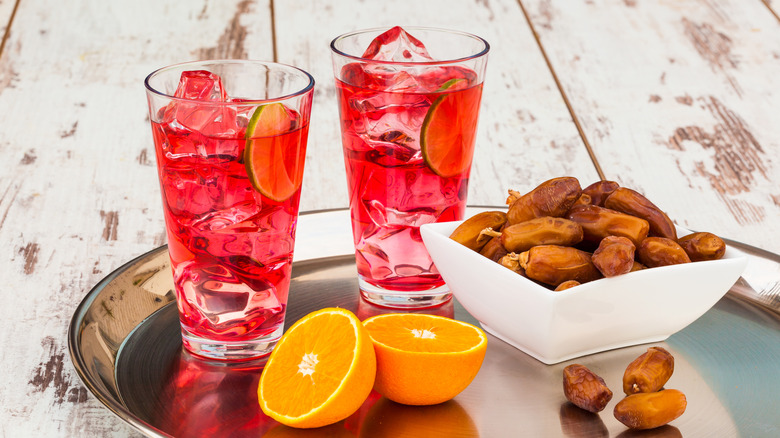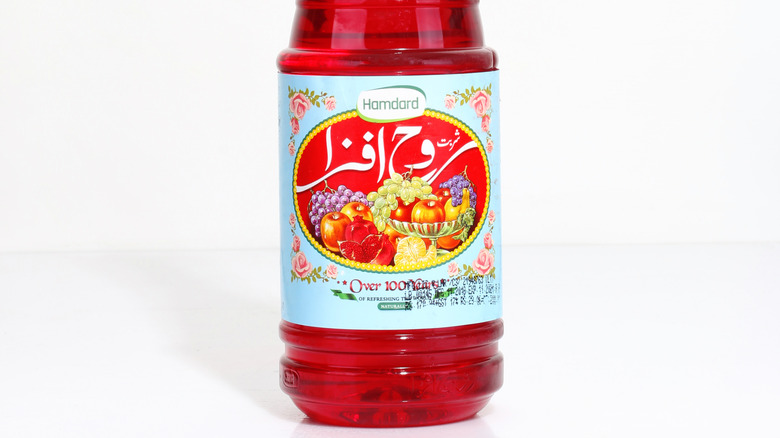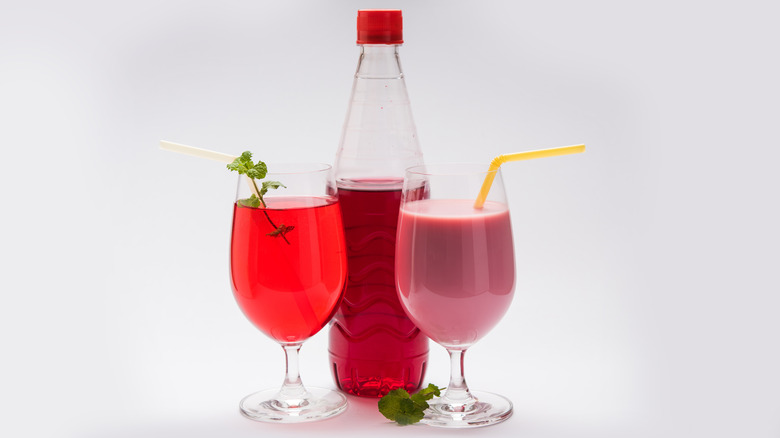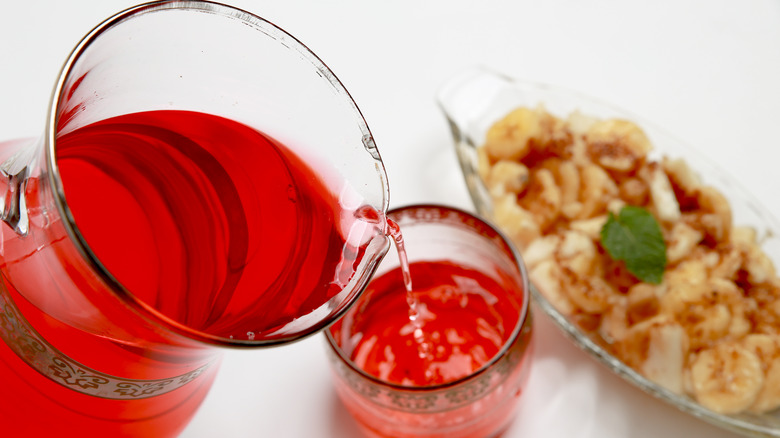Rooh Afza Is The South Asian Pantry Staple That Adds A Floral Taste To Drinks
Whether it's watermelon juice, lemonade, or a seltzer, some drinks just hit the spot during a hot summer day. Not only do such options hydrate with more flavor, but they often offer some minerals and nutrients, too.
In South Asia — specifically Pakistan, Bangladesh, and India — a beloved non-alcoholic refreshment is called Rooh Afza. A flavor-dense syrup, just a spoonful of this floral essence creates a delightful result. The taste's sweet but backed by spice, with pandan and rose water comprising the two principal notes.
In addition to dilution into milk and water, the floral extract adds a complex note to everything from ice creams to cakes. No surprise it's ubiquitous across the South Asian continent, found everywhere from markets to household pantries. Just a spoon of the essence goes a long way in imbuing a complex flavor or creating a refreshing drink on its own. Let's dive into what Rooh Afza's all about.
What is Rooh Afza?
The eye-catching red bottle is a syrup, combing an extensive array of fruit juices, herbs, and spices. It emerged in 1907 when a herbal shop owner named Hakim Abdul Majid set out to create a remedy for the hot temperatures in India. Although his result did not carry medicinal effects, the combination of ingredients proved to be delightfully refreshing.
After the partition of India in 1947, the brand split into three separate companies with manufacturing centers in Bangladesh, India, and Pakistan. All remained operated by friends and acquaintances — maintaining nearly the same recipe as the original. Today, Rooh Afza still exhibits an almost identical taste to the original.
The drink is especially popular during Ramadan, Eid, and Hindu festivities. And it's especially prevalent come summertime, an affordable solace from the heat. Its distinct bright red color is enjoyed at markets, in restaurants, and served inside the home. Diluted with chilled water or integrated into complicated dishes, it makes for an aromatic — as well as rejuvenating — sweetened beverage.
How is Rooh Afza made?
The blend of ingredients in Rooh Afza is complex — with slight deviations depending on the producer's location. Two core flavors are rose water, which offers a refreshing floral base, compounded with Screwdriver Pine, which is an aromatic essence in the pandan family. Further additions include fruit juices from pineapple and orange, dried grapes as well as vegetables like carrots, cucumber, spinach, and endive. The spiced additions are dizzying; everything from mint and coriander to medicinal components like borage leaves, and stone flowers.
Assembly of the essence starts with distilling over a dozen herbs and spices into a concentrate called ark. After a slow condensing process, the result is combined with the fruit juices. Next, it's all blended with a liquified sugar mixture, which forms almost 90% of the sherbert. With a finish of food coloring, the Rooh Afza is bottled and ready for distribution. Packed with flavor, it is no surprise it tastes delicious without accompaniments.
How to drink Rooh Afza
The bottled syrup is a drink base, meaning it's necessary to dilute it further after purchase. Simple water does the job; however, versions with milk are equally popular. The syrup is flavor dense; it only requires around a tablespoon of the extract per cup of liquid. And no equipment is necessary to mix it together — just mix with a spoon.
Depending on preference, some add in more sugar or textural additions like sabja seeds, which resemble chia. In Pakistan, Rooh Afza is often blended with crushed almonds, lending it a thicker consistency. Past such popular standard renditions, the syrup can be integrated into more complicated preparations, too.
For an alcoholic take, the essence works well alongside champagne and gin, creating a wondrously aromatic French 75. Or, in adherence to South Asian foods, it can be utilized as the principal flavoring in a lassi. The syrup's flavor functions in a diverse array of applications — just remember a little bit goes a long way.
Dishes with Rooh Afza
In addition to its popularity in liquefied applications, Rooh Afza is utilized in edible treats, too. Dishes range from cold sweets like popsicles to intricate baked goods, such as soufflés. An especially common application is in custards and mousses — the essence shines in a creamy medium.
An airy texture can be achieved with gelatin and whipped cream, which will pair with pistachios. Or, it can be cooked down with cornstarch and fruit, yielding a more liquid result. Most traditionally, it's prepared into kheer, a custard slow-cooked with rice and milk.
Chocolate lovers should reach for the essence, too; it melds in everything from hot chocolate to a white cocoa bark. Its floral flavor deliciously cuts through cocoa's fat content — hence there are even Rooh Afza-flavored chocolate bars. While the flavor's bold, it'll accompany well with a medley of notes — from coconut to Nutella. Such malleability showcases why the bar's such a hit. Refreshing, complex, yet easy to enjoy, it's a South Asian hit that's always worth a spot in the pantry.




